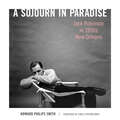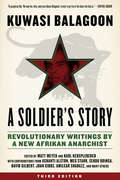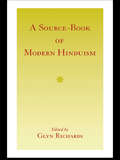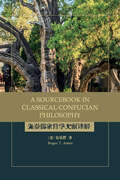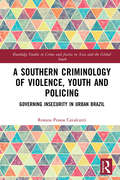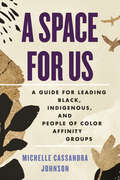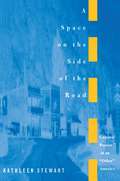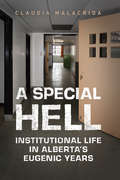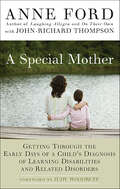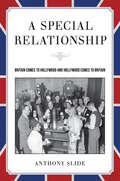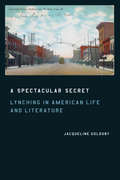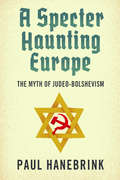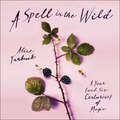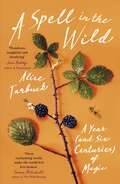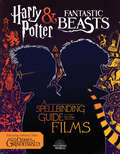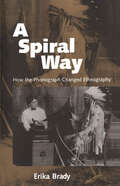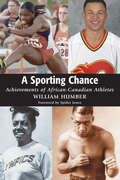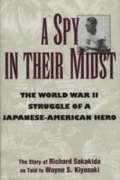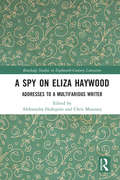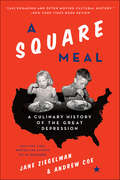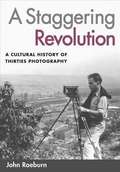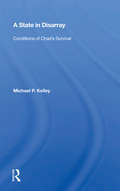- Table View
- List View
A Sojourn in Paradise: Jack Robinson in 1950s New Orleans
by Howard Philips SmithJack Robinson made his name as a much-sought-after fashion and celebrity photographer during the 1960s and early 1970s, and his work is well documented in hundreds of pages of Vogue, the New York Times, and Life, as well as other publications. However, his personal life remains virtually unknown. In this study of Robinson and his photography, Howard Philips Smith takes an in-depth look at Robinson’s early life in New Orleans, where he discovered his passion for painting, photography, and the Dixie Bohemian life of the French Quarter. A Sojourn in Paradise: Jack Robinson in 1950s New Orleans features more than one hundred photographs taken by the artist, accompanied by detailed commentary about Robinson’s life in New Orleans and excerpts from interviews with the people who knew him when he lived there. Robinson’s photographs of New Orleans reveal the genesis of two unique and fascinating facets of the city’s history and culture: the creation of the first gay Carnival krewes who would make their own unique contribution to the rich cultural history of the city and the formation of the Orleans Gallery, one of the earliest centers of the contemporary art movement blossoming in 1950s America. This detailed study of Jack Robinson’s early life and photography illustrates the contributions of a gifted, gay artist whose quiet spirit and constant interior struggle found refuge in New Orleans, the city where he was able to find himself, for a time, free from society’s grip and open to exploring life on his own terms.
A Soldier's Story: Revolutionary Writings by a New Afrikan Anarchist (Kersplebedeb)
by Kuwasi BalagoonKuwasi Balagoon was a participant in the Black Liberation struggle from the 1960s until his death in prison in 1986. A member of the Black Panther Party and defendant in the infamous Panther 21 case, Balagoon went underground with the Black Liberation Army (BLA). Balagoon was unusual for his time in that he combined anarchism with Black nationalism, broke the rules of sexual and political conformity, took up arms against the white supremacist State—all the while never shying away from critiquing the movements's weaknesses. The first part of this book consists of contributions by those who knew or were touched by Balagoon; the second consists of court statements and essays by Balagoon himself, including several documents which have never been published before. The third section consists of excerpts from letters Balagoon wrote while in prison. A final section includes a historical essay by Akinyele Umoja and an extensive intergenerational roundtable discussion of the significance of Balagoon's life and thoughts today.
A Source-Book of Modern Hinduism
by Glyn RichardsThrough a balanced selection of texts with commentaries, this work combines an approach to the renaissance of Hinduism and the reformation of Indian society.
A Sourcebook in Classical Confucian Philosophy (SUNY series in Chinese Philosophy and Culture)
by Roger T. AmesApplies a method of comparative cultural hermeneutics to let the tradition speak on its own terms.Roger T. Ames's A Sourcebook in Classical Confucian Philosophy is a companion volume to his Conceptual Lexicon for Classical Confucian Philosophy. It includes texts in the original classical Chinese along with their translations, allowing experts and novices alike to make whatever comparisons they choose. In applying a method of comparative cultural hermeneutics, Ames has tried to let the tradition speak on its own terms. The goal is to encourage readers to move between the translated text and commentary, the philosophical introduction that attempts to sensitize them to the interpretative context, and the companion Lexicon of key philosophical terms, with the expectation that in the fullness of time they will be able to appropriate the original Chinese terminologies themselves. Armed with their own increasingly robust insight into these philosophical terms, readers will be able to carry this nuanced understanding over into their critical reading of other available translations. Ultimately, for students who would understand Chinese philosophy, tian天must be understood as tian天, and dao道must be dao道.
A Southern Criminology of Violence, Youth and Policing: Governing Insecurity in Urban Brazil (Routledge Studies in Crime and Justice in Asia and the Global South)
by Roxana Pessoa CavalcantiA Southern Criminology of Violence, Youth and Policing examines public experiences of insecurity and the social impacts of security programmes that aim to address violence in Brazil. This book contributes to the emerging field of southern criminology by engaging with the perils faced by people living in ‘favelas’ in Brazil and critically investigating the discourse of state actors. It combines original ethnographic data with critical analysis to expand understandings of violence and control in urban and postcolonial contexts. This study challenges dominant practices and notions of security and control. Its objective is to decolonise knowledge and shed light on issues relating to policing, coercion, and the great socioeconomic, historical and spatial inequalities that shape the lives of millions of people in the Global South. The findings of this book expose the exacerbation of social problems by the expansion of the penal and crime industry, unsettling the applicability and universalism of mainstream managerial criminology. The evidence reveals that new modes of securitisation have not addressed long-standing issues of sexism, racism, classism and brutalisation in the police. Moreover, through the increasing use of methods of control and incarceration, security programmes have failed to prevent diverse forms of violence and challenge the expansion of organised crime. Instead they have exacerbated the inequalities that affect the most marginalised populations. Written in a clear and direct style, this book will appeal to students and scholars in criminology, sociology, cultural studies, social theory and those interested in learning about the social injustices that exists in the Global South.
A Space for Us: A Guide for Leading Black, Indigenous, and People of Color Affinity Groups
by Michelle Cassandra Johnson&“A helpful introduction to facilitating affinity spaces in an inclusive, emergent, and trauma-informed way to foster the communal healing spaces that in turn ignite community action and liberation.&”—Resmaa Menakem, best-selling author of My Grandmother&’s Hands and Monsters in LoveThe first comprehensive guide for leading BIPOC affinity groups for challenging white supremacy, healing racial trauma, and taking collective actionMeeting in racial affinity groups is a common practice in anti-racist, social justice, diversity, and similar forms of educational endeavors. These groups provide a structured space in which participants can explore how racism personally impacts them, process specific experiences of racism, receive validation and support from their peers, heal, and strategize next steps for challenging racism, white supremacy, and internalized racial oppression.In A Space for Us, Michelle Cassandra Johnson brings her over 20 years of experience leading dismantling racism work to provide the first affinity groups guide made for BIPOC communities. This essential guide will: Provide an understanding of the racial hierarchy and how it has impacted Black, Indigenous, and People of Color differently.Define and share common manifestations of internalized racial oppression.Define anti-Blackness and provide skills to interrupt and address it. Share rituals, practices, and sample agendas for affinity groups.Explain when it is useful to meet as one BIPOC group and when it is useful to meet based on one&’s specific racial identity.Provide rituals and tools for healing in BIPOC affinity groups.Provide information about how to come back together as BIPOC and white people to strategize and take collective action. Comprehensive and accessible, A Space for Us offers practical guidance for facilitating effective BIPOC racial affinity groups and will be an important resource for BIPOC communities.
A Space on the Side of the Road: Cultural Poetics in an "Other" America
by Kathleen StewartA Space on the Side of the Road vividly evokes an "other" America that survives precariously among the ruins of the West Virginia coal camps and "hollers." To Kathleen Stewart, this particular "other" exists as an excluded subtext to the American narrative of capitalism, modernization, materialism, and democracy. In towns like Amigo, Red Jacket, Helen, Odd, Viper, Decoy, and Twilight, men and women "just settin'" track a dense social imaginary through stories of traumas, apparitions, encounters, and eccentricities. Stewart explores how this rhythmic, dramatic, and complicated storytelling imbues everyday life in the hills and forms a cultural poetics. Alternating her own ruminations on language, culture, and politics with continuous accounts of "just talk," Stewart propels us into the intensity of this nervous, surreal "space on the side of the road." It is a space that gives us a glimpse into a breach in American society itself, where graveyards of junked cars and piles of other trashed objects endure along with the memories that haunt those who have been left behind by "progress." Like James Agee's portrayal of the poverty-stricken tenant farmers of the Depression South in Let Us Now Praise Famous Men, this book uses both language and photographs to help readers encounter a fragmented and betrayed community, one "occupied" by schoolteachers, doctors, social workers, and other professionals representing an "official" America. Holding at bay any attempts at definitive, social scientific analysis, Stewart has concocted a new sort of ethnographic writing that conveys the immediacy, density, texture, and materiality of the coal camps. A Space on the Side of the Road finally bridges the gap between anthropology and cultural studies and provides us with a brilliant and challenging experiment in thinking and writing about "America."
A Special Hell: Institutional Life in Alberta's Eugenic Years
by Claudia MalacridaUsing rare interviews with former inmates and workers, institutional documentation, and governmental archives, Claudia Malacrida illuminates the dark history of the treatment of "mentally defective" children and adults in twentieth-century Alberta. Focusing on the Michener Centre in Red Deer, one of the last such facilities operating in Canada, A Special Hell is a sobering account of the connection between institutionalization and eugenics. Malacrida explains how isolating the Michener Centre's residents from their communities served as a form of passive eugenics that complemented the active eugenics program of the Alberta Eugenics Board. Instead of receiving an education, inmates worked for little or no pay - sometimes in homes and businesses in Red Deer - under the guise of vocational rehabilitation. The success of this model resulted in huge institutional growth, chronic crowding, and terrible living conditions that included both routine and extraordinary abuse. Combining the powerful testimony of survivors with a detailed analysis of the institutional impulses at work at the Michener Centre, A Special Hell is essential reading for those interested in the disturbing past and troubling future of the institutional treatment of people with disabilities.
A Special Mother: Getting Through the Early Days of a Child's Diagnosis of Learning Disabilities and Related Disorders
by Anne Ford John-Richard ThompsonAll mothers experience worries and fears about their children, but none can compare with the early days when a mother feels something's not quite right. Anne Ford knows the feeling. She's had it herself, having raised a daughter with severe learning disabilities, and has gone on to share experiences with others during her many years as a volunteer with the National Center for Learning Disabilities.To bring comfort, support, and hard information to mothers-and fathers, too-in the early period surrounding the diagnosis, here is the book that Anne wishes she'd had years ago when she first received the news about her daughter and didn't know where to turn for the practical and emotional help she desperately needed.Filled with essential advice and the voices of other mothers whose children have LD and related disorders such as Asperger's and ADHD, A Special Mother lets parents know they are not alone and that they can help their child to thrive. This invaluable book addresses such matters as:Understanding Learning Disabilities and Related DisordersWhat Should You Do First?Interpreting Evaluation ResultsResolving DisputesSpecial Fathers: They Are Out ThereThe Social Side of LDAdvocacy vs. ObsessionHow Are You Doing?: Taking Care of Yourself
A Special Relationship: Britain Comes to Hollywood and Hollywood Comes to Britain
by Anthony SlideA Special Relationship provides not only a historical overview of the British in Hollywood, but also a detailed study of the contributions made by American individuals and companies to British cinema from the beginning of the twentieth century onwards. The story begins with Ohio-born Charles Urban who came to London in 1898 and deserves credit for major involvement in the creation of a British film industry. While Ireland was still a part of Britain, the New York-based Kalem Company made films there from 1910 to 1913. British producers realized the importance of American stars, and many actors, beginning with Florence Turner (who was arguably also the first American star), made numerous British films. In the 1920s, such Hollywood stars as Mae Marsh, Betty Blythe, and Dorothy Gish remained active in Britain. In the 1930s, as their careers came to a halt, more than one hundred former American stars made the trip to England, partly as a vacation and partly in the hope of reenergizing their careers.Chapters discuss American cinematographers at work in Britain in the 1920s and 1930s and the introduction of Technicolor to British films. Diversity is represented by African American performers (most notably Paul Robeson), the Chinese American star Anna May Wong, along with female filmmakers from Hollywood. With Britain's declaration of war on Germany, there were Americans who stayed, such as Bebe Daniels and Ben Lyon, contributing to the war effort. America became actively involved in British cinema after World War II, with many Hollywood studios producing films there. As the years progressed, the British film industry became an international film industry. The book concludes with the Harry Potter and James Bond series, indicative of a new international cinema, with financing and behind-the-camera talent coming from the United States, but with British locales and British stars.
A Spectacular Secret: Lynching in American Life and Literature
by Jacqueline GoldsbyThis incisive study takes on one of the grimmest secrets in America's national life—the history of lynching and, more generally, the public punishment of African Americans. Jacqueline Goldsby shows that lynching cannot be explained away as a phenomenon peculiar to the South or as the perverse culmination of racist politics. Rather, lynching—a highly visible form of social violence that has historically been shrouded in secrecy—was in fact a fundamental part of the national consciousness whose cultural logic played a pivotal role in the making of American modernity. To pursue this argument, Goldsby traces lynching's history by taking up select mob murders and studying them together with key literary works. She focuses on three prominent authors—Ida B. Wells-Barnett, Stephen Crane, and James Weldon Johnson—and shows how their own encounters with lynching influenced their analyses of it. She also examines a recently assembled archive of evidence—lynching photographs—to show how photography structured the nation's perception of lynching violence before World War I. Finally, Goldsby considers the way lynching persisted into the twentieth century, discussing the lynching of Emmett Till in 1955 and the ballad-elegies of Gwendolyn Brooks to which his murder gave rise. An empathic and perceptive work, A Spectacular Secret will make an important contribution to the study of American history and literature.
A Spectacular Secret: Lynching in American Life and Literature
by Jacqueline GoldsbyThis incisive study takes on one of the grimmest secrets in America's national life—the history of lynching and, more generally, the public punishment of African Americans. Jacqueline Goldsby shows that lynching cannot be explained away as a phenomenon peculiar to the South or as the perverse culmination of racist politics. Rather, lynching—a highly visible form of social violence that has historically been shrouded in secrecy—was in fact a fundamental part of the national consciousness whose cultural logic played a pivotal role in the making of American modernity. To pursue this argument, Goldsby traces lynching's history by taking up select mob murders and studying them together with key literary works. She focuses on three prominent authors—Ida B. Wells-Barnett, Stephen Crane, and James Weldon Johnson—and shows how their own encounters with lynching influenced their analyses of it. She also examines a recently assembled archive of evidence—lynching photographs—to show how photography structured the nation's perception of lynching violence before World War I. Finally, Goldsby considers the way lynching persisted into the twentieth century, discussing the lynching of Emmett Till in 1955 and the ballad-elegies of Gwendolyn Brooks to which his murder gave rise. An empathic and perceptive work, A Spectacular Secret will make an important contribution to the study of American history and literature.
A Spectacular Secret: Lynching in American Life and Literature
by Jacqueline GoldsbyThis incisive study takes on one of the grimmest secrets in America's national life—the history of lynching and, more generally, the public punishment of African Americans. Jacqueline Goldsby shows that lynching cannot be explained away as a phenomenon peculiar to the South or as the perverse culmination of racist politics. Rather, lynching—a highly visible form of social violence that has historically been shrouded in secrecy—was in fact a fundamental part of the national consciousness whose cultural logic played a pivotal role in the making of American modernity. To pursue this argument, Goldsby traces lynching's history by taking up select mob murders and studying them together with key literary works. She focuses on three prominent authors—Ida B. Wells-Barnett, Stephen Crane, and James Weldon Johnson—and shows how their own encounters with lynching influenced their analyses of it. She also examines a recently assembled archive of evidence—lynching photographs—to show how photography structured the nation's perception of lynching violence before World War I. Finally, Goldsby considers the way lynching persisted into the twentieth century, discussing the lynching of Emmett Till in 1955 and the ballad-elegies of Gwendolyn Brooks to which his murder gave rise. An empathic and perceptive work, A Spectacular Secret will make an important contribution to the study of American history and literature.
A Specter Haunting Europe: The Myth of Judeo-Bolshevism
by Paul HanebrinkIn the 20th century, Europe was haunted by a specter of its own imagining: Judeo-Bolshevism. Fear of a Jewish Bolshevik plot to destroy the nations of Europe took hold during the Russian Revolution and spread across the continent. Paul Hanebrink shows that the myth of ethno-religious threat is still alive today, in Westerners’ fear of Muslims.
A Spell in the Wild: A Year (and six centuries) of Magic
by Alice Tarbuck'Witches occupy a clear place in contemporary imagination. We can see them, shadowy, in the corners of the past: mad, glamorous, difficult, strange. They haunt the footnotes of history - from medieval witches burning at the stake to the lurid glamour of the 1970s witchcraft revival. But they are moving out of history, too. Witches are back. They're feminist, independent, invested in self-care and care for the world. They are here, because they must be needed.'What it means to be a witch has changed radically throughout history; where 'witch' was once a dangerous - and often deadly - accusation, it is now a proud self-definition. Today, as the world becomes ever more complicated and as we face ecological, political and economic crisis - witchcraft is experiencing a resurgence. Witches are back.In A Spell in the Wild, Alice Tarbuck explores what it means to be a witch today. Rooted in the real world, but filled with spells, rituals and recipes, this book is an accessible, seasonal guide to witchcraft in the twenty-first century. Following the course of a witch's calendar year while also exploring the history and politics of witchcraft, A Spell in the Wild is the perfect primer for the contemporary witch.(P) 2020 Hodder & Stoughton Ltd
A Spell in the Wild: A Year (and six centuries) of Magic
by Alice Tarbuck'Witches occupy a clear place in contemporary imagination. We can see them, shadowy, in the corners of the past: mad, glamorous, difficult, strange. They haunt the footnotes of history - from medieval witches burning at the stake to the lurid glamour of the 1970s witchcraft revival. But they are moving out of history, too. Witches are back. They're feminist, independent, invested in self-care and care for the world. They are here, because they must be needed.'What it means to be a witch has changed radically throughout history; where 'witch' was once a dangerous - and often deadly - accusation, it is now a proud self-definition. Today, as the world becomes ever more complicated and as we face ecological, political and economic crisis - witchcraft is experiencing a resurgence. Witches are back.In A Spell in the Wild, Alice Tarbuck explores what it means to be a witch today. Rooted in the real world, but filled with spells, rituals and recipes, this book is an accessible, seasonal guide to witchcraft in the twenty-first century. Following the course of a witch's calendar year while also exploring the history and politics of witchcraft, A Spell in the Wild is the perfect primer for the contemporary witch.
A Spell in the Wild: A Year (and six centuries) of Magic
by Alice Tarbuck'Witches occupy a clear place in contemporary imagination. We can see them, shadowy, in the corners of the past: mad, glamorous, difficult, strange. They haunt the footnotes of history - from medieval witches burning at the stake to the lurid glamour of the 1970s witchcraft revival. But they are moving out of history, too. Witches are back. They're feminist, independent, invested in self-care and care for the world. They are here, because they must be needed.'What it means to be a witch has changed radically throughout history; where 'witch' was once a dangerous - and often deadly - accusation, it is now a proud self-definition. Today, as the world becomes ever more complicated and as we face ecological, political and economic crisis - witchcraft is experiencing a resurgence. Witches are back.In A Spell in the Wild, Alice Tarbuck explores what it means to be a witch today. Rooted in the real world, but filled with spells, rituals and recipes, this book is an accessible, seasonal guide to witchcraft in the twenty-first century. Following the course of a witch's calendar year while also exploring the history and politics of witchcraft, A Spell in the Wild is the perfect primer for the contemporary witch.
A Spellbinding Guide to the Films (Follow Me Around... Ser.)
by Michael KoggeFantastic Beasts: The Crimes of Grindelwald is coming to theaters November 16, 2018! Explore the new film series and its connections to Harry Potter with this beautiful handbook!As Fantastic Beasts: The Crimes of Grindelwald breaks new ground, it's time to get up to speed on the films of J.K. Rowling's wizarding world! This handy handbook has everything fans need to sort hippogriffs from horcruxes, trace the lineage of the most noble wizarding families, explore the different wizarding governments, and study Hogwarts from the early 1900s on. This beautiful guide is the perfect deep dive into Harry Potter and Fantastic Beasts and how the two worlds are connected, complete with family trees, infographics, and more.
A Spiral Way: How the Phonograph Changed Ethnography
by Erika BradyAssociation of Recorded Sound Collections Awards for ExcellenceBest Research in the General History of Recorded Sound (2000)The invention of the cylinder phonograph at the end of the nineteenth century opened up a new world for cultural research. Indeed, Edison's talking machine became one of the basic tools of anthropology. It not only equipped researchers with the means of preserving folk songs but it also enabled them to investigate a wide spectrum of distinct vocal expressions in the emerging fields of anthropology and folklore. Ethnographers grasped its huge potential and fanned out through regional America to record rituals, stories, word lists, and songs in isolated cultures. From the outset the federal government helped fuel the momentum to record cultures that were at risk of being lost. Through the Bureau of American Ethnology, the Smithsonian Institution took an active role in preserving native heritage. It supported projects to make phonographic documentation of American Indian language, music, and rituals before developing technologies and national expansion might futher undermine them. This study of the early phonograph's impact shows traditional ethnography being transformed, for attitudes of both ethnographers and performers were reshaped by this exciting technology. In the presence of the phonograph both fieldwork and the materials collected were revolutionized. By radically altering the old research modes, the phonograph brought the disciplines of anthropology and folklore into the modern era. At first the instrument was as strange and new to the fieldworkers as it was to their subjects. To some the first encounter with the phonograph was a deeply unsettling experience. When it was demonstrated in 1878 before members of the National Academy of Sciences, several members of the audience fainted. Even its inventor was astonished. Of his first successful test of his tinfoil phonograph, Thomas A. Edison said, "I was never taken so aback in my life." The cylinders that have survived from these times offer an unrivaled resource not only for contemporary scholarship but also for a grassroots renaissance of cultural and religious values. In tracing the historical interplay of the talking machine with field research, A Spiral Way underscores the natural adaptablity of cultural study to this new technology.
A Sporting Chance: Achievements of African-Canadian Athletes
by William Humber Spider JonesOver the years, Canadians have smugly asserted their country’s more tolerant culture in race relations. Yet as this story of African-Canadian participation in sports demonstrates, the record is far more troubling. In reality, Canada’s record in matters of race was a disturbing blend of occasional good intentions and ugly practices. The study of the Black athletic experience in Canada is not only a revealing portrait into our past, but also one more demonstration of some time-honoured truths about human achievement and the necessity of the public will to provide open and fair forums for equal access to participation. Presented in a chronological sequence, individual sports are presented along with the leading athletes who brought grace and a determination to achieve. Included are George Dixon, Sam Langford, Reuben Mayes, Ray Lewis, Sam Richardson, Dr. Phil Edwards, Jackie Robinson, Harry Jerome, Earl Walls, Donovan Bailey, Sylvia Sweeney, Molly Killingbeck, Herb Carnegie, Jamaal Magliore, Perdita Felicien and Jarome Iginla, to name but a few of the fine athletes who form a part of Canada’s sports heritage. "As Canada’s foremost baseball historian, Bill Humber has chronicled another fascinating chapter from Canada’s rich sports history. This is an excellent read – entertaining, educational and expertly researched. As my pal Don Cherry might say: ’Two thumbs up, Bill.’"– Brian McFarlane, Sports Family Ltd.
A Spy In Their Midst: The World War Ii Struggle Of A Japanese-american Hero
by Wayne S. Kiyosaki Richard Sakakida<P>During World War II, while thousands of Japanese-Americans were being sent to U.S. detainment camps, a Japanese-American from Hawaii working as a U.S. Army spy in the Philippines was captured by the enemy.<P> Richard Sakakida was the only Japanese-American prisoner of the Japanese forces, and he faced death as a "traitor" because of his Japanese face.<P> Despite unspeakable torture, Sakakida stubbornly refused to confess that he was an American spy; ironically, his Japanese cultural heritage is what enabled him to survive the beatings inflicted on him by his Japanese captors.<P> Sakakida narrowly escaped a death sentence and was assigned to the office of a Japanese official, where he gained valuable military information for MacArthur and engineered a daring prison break that freed a Filipino guerrilla leader and hundreds of his followers. <P>Fifty years later, Sakakida finally tells his tale of survival and perseverance against incredible odds.
A Spy on Eliza Haywood: Addresses to a Multifarious Writer (Routledge Studies in Eighteenth-Century Literature)
by Aleksondra HultquistEliza Haywood was one of the most prolific English writers in the Age of the Enlightenment. Her career, from Love in Excess (1719) to her last completed project The Invisible Spy (1755) spanned the gamut of genres: novels, plays, advice manuals, periodicals, propaganda, satire, and translations. Haywood’s importance in the development of the novel is now well-known. A Spy on Eliza Haywood links this with her work in the other genres in which she published at least one volume a year throughout her life, demonstrating how she contributed substantially to making women’s writing a locus of debate that had to be taken seriously by contemporary readers, as well as now by current scholars of political, moral, and social enquiries into the eighteenth century. Haywood’s work is essential to the study of eighteenth-century literature and this collection of essays continues the growing scholarship on this most important of women writers.
A Square Meal: A Culinary History of the Great Depression
by Jane Ziegelman Andrew CoeJames Beard Foundation Book Award WinnerFrom the author of the acclaimed 97 Orchard and her husband, a culinary historian, an in-depth exploration of the greatest food crisis the nation has ever faced—the Great Depression—and how it transformed America’s culinary culture.The decade-long Great Depression, a period of shifts in the country’s political and social landscape, forever changed the way America eats. Before 1929, America’s relationship with food was defined by abundance. But the collapse of the economy, in both urban and rural America, left a quarter of all Americans out of work and undernourished—shattering long-held assumptions about the limitlessness of the national larder.In 1933, as women struggled to feed their families, President Roosevelt reversed long-standing biases toward government-sponsored “food charity.” For the first time in American history, the federal government assumed, for a while, responsibility for feeding its citizens. The effects were widespread. Championed by Eleanor Roosevelt, “home economists” who had long fought to bring science into the kitchen rose to national stature.Tapping into America’s long-standing ambivalence toward culinary enjoyment, they imposed their vision of a sturdy, utilitarian cuisine on the American dinner table. Through the Bureau of Home Economics, these women led a sweeping campaign to instill dietary recommendations, the forerunners of today’s Dietary Guidelines for Americans.At the same time, rising food conglomerates introduced packaged and processed foods that gave rise to a new American cuisine based on speed and convenience. This movement toward a homogenized national cuisine sparked a revival of American regional cooking. In the ensuing decades, the tension between local traditions and culinary science has defined our national cuisine—a battle that continues today. A Square Meal examines the impact of economic contraction and environmental disaster on how Americans ate then—and the lessons and insights those experiences may hold for us today.A Square Meal features 25 black-and-white photographs.
A Staggering Revolution: A Cultural History of Thirties Photography
by John RaeburnDuring the 1930s, the world of photography was unsettled, exciting, and boisterous. John Raeburn's A Staggering Revolution recreates the energy of the era by surveying photography's rich variety of innovation, exploring the aesthetic and cultural achievements of its leading figures, and mapping the paths their pictures blazed public's imagination. While other studies of thirties photography have concentrated on the documentary work of the Farm Security Administration (FSA), no previous book has considered it alongside so many of the decade's other important photographic projects. A Staggering Revolution includes individual chapters on Edward Steichen's celebrity portraiture; Berenice Abbott's Changing New York project; the Photo League's ethnography of Harlem; and Edward Weston's western landscapes, made under the auspices of the first Guggenheim Fellowship awarded to a photographer. It also examines Margaret Bourke-White's industrial and documentary pictures, the collective undertakings by California's Group f.64, and the fashion magazine specialists, as well as the activities of the FSA and the Photo League.
A State In Disarray: Conditions Of Chad's Survival
by Michael P. KelleyAlthough independent since 1960, Chad has proved to be one of the least viable African states. Sustained politically and financially by other countries from the outset, Chad's internal warfare has made it the prey of external powers. Yet Chad has survived–an integral element of the Organization of African Unity's Pax Africana and of a peaceful trans-Saharan Africa. Its jeopardized survival is a shaky testimony to the continuing validity of the African continent's colonial-based states-system–underwritten by the OAU and the UN–and at the same time it provides a striking example of the cumulative effects of Africa's post-independence problems. Examining the state's internal weakness and the degree and nature of its foreign involvements, the author focuses on Chad's continuing dilemma: The outside support so crucial for viability is the very thing that undermines its international standing. The roles of Libya, France, the United States, the UN, the OAU, and the trans-Saharan regional subsystem are also analyzed as the author illuminates the quandary of supporting the state without aggravating its conflicts.
